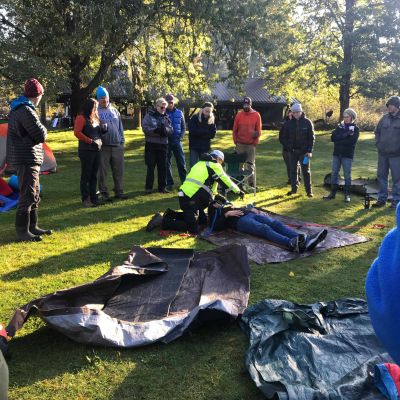WFA Class
Wilderness First Aid
Submitted by Chrissy Bloome
Photos by Matt Saucy and Jeanie Mercier Smith
The North Santiam River provided a great location for the 2 days of the OWA sponsored Wilderness First Aid course October 5-6, 2019. Fortu-nately, the heaviest of early fall rain downpour happened on Friday, late afternoon before the course started, but just in time to make for damp and cold conditions for setting up camp for the weekend for those who could arrive a little early on Friday evening. Throughout the weekend, everyone was grateful for the covered shelter area with great tables, easy access to water and even electric stovetop coils. Overall, things were fairly dry and the early shifting of fall colors by the river made for a beautiful setting.
Matt Saucy headed up the coordination and implementation of this won-derful training supported by Heather. Everyone had info prior to the train-ing and during about what to expect. Matt and Heather kept a hearty supply of hot coffee, tea, and yummy snacks, which kept everyone fueled throughout the weekend. Travis Reid and his team, Brian and Matt, were set up to teach participants relevant and specific Wilderness First Aid content. With the help of the team and OWA volunteers, everyone got to rotate through stations to apply the content that was taught to the large group. Clearly, this endeavor takes a lot of organization and equipment
Participants ranged from those with prior training and experience to those with little or no training. There was something for everyone and even for those with prior training, the repetition and practice of a course like this always strengthens knowl-edge and skills. The Patient Assessment System (PAS) is a foundational way to address a wilderness situation that needs first aid attention. Recognizing when to call for help asap is essential and when/how to use a personal location device was discussed. When dealing with situations, “Fast is S-L-O-W and Smooth is Fast,” was an enduring theme. The prioritizing of rescue is #1 – Self, #2, other rescuers, and #3 Victim.
Some of the major content areas included cervical spine precautions, heat exhaus-tion, shock, cardiac arrest (effective com-pressions and early defibrillation with
an AED), bleeding control, hypothermia, shock, altitude sickness, lightning, and traumatic brain injury.
On both days 1 and 2, simulations with situations related to river-related incidents provided partici-pants a hands-on opportunity to apply knowledge and practice right next to the river. Victims were moulaged and stayed in character in simulated roles while Wilderness First Aid responders attended to assist them using the skills learned during practice stations. Roles for Incident Command and all the other coordination further assisted opportunities for practice. The “hypothermia burrito” active practice during the simulation was an especially challeng-ing situation to accomplish followed by evacuation of the victim. At the conclusion of the simulations, large group debriefing gave everyone an oppor-tunity to converse about the training and how the hands-on practice went. Many lessons were learned! Continued practice is a definite plus to integrate all this great information.
Many lessons were learned! Continued practice is a definite plus to integrate all this great information.
A big shout out goes to Matt and Heather for the fantastic course coordination, food and hot bever-ages and Travis Reid and the team for getting this training to OWA members. A lot more people are better equipped to handle situations that may occur on adventures of many kinds. Again, OWA contin-ues to provide very affordable training! Look for the training again with “perfect vision” in 2020!










